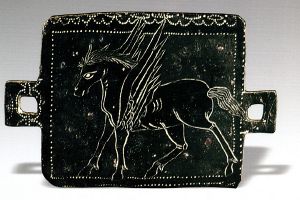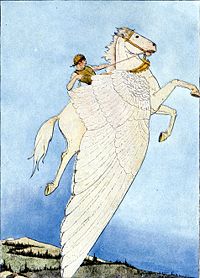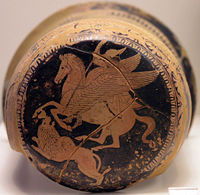Pegasus
There have many images of horses with wings throughout the ages, but all come the creature in Greek mythology known as Pegasus, or Πήγασος (Pégasos)) in Greek Language. Variations of the story do exist, but nonetheless the story of Pegasus and the tragic hero Bellerophon is a classic in mythology.
Etymology
Hesiod connects the name Pegasos with the word for "spring, well", pēgē; everywhere the winged horse struck hoof to earth, an inspiring spring burst forth: one on the Muses' Mount Helicon, the Hippocrene ("horse spring"), at the behest of Poseidon to prevent the mountain swelling too much and another at Troezen. The actual etymology of the name is most likely from Luwian pihassas "lightning", or pihassasas, a weather god (the god of lightning). In Hesiod, Pegasos is still associated with this original significance by carrying the thunderbolts for Zeus.
Origin
Unlike some other mythical creatures, it is unlikely that Pegasus is based on a real animal of the time, or a misunderstanding of fossilized remains. Rather, Pegasus seems to be an entirely fictitious creation, although horses were often central in mythology and cultures (e.g. Unicorn). It is generally accepted that when Perseus beheaded the Gorgon (more popularly known today as Medusa) Pegasus sprang forth from her severed neck, keeping in accord with the idea of a "higher" birth, like the birth of Athena from the head of Zeus. The most common variant of states that Pegasus was born of the earth as Medusa's blood spilled onto it and then into the sea foam. Since the God of the Sea, Poseidon is often said to be the father of Pegasus, this account seems more congruent then the other, although the nature of Greek mythology is often fragmented and often lacks a clear sense of continuity.
Mythological References

Pegasus appears longest in the story of Bellerophon. The son of King Glaucus, a warrior known for his breeding of fierce horses who betrayed and devoured him, Bellerophon was rumored to come from divine parentage, but even if not, he was by far the strongest and most handsome young man in his kingdom. He desired to tame Pegasus and was shown a way by Athena after he slept in her temple one night; presenting him with a golden bridle, Bellerophon mastered Pegasus, and together the two had many adventures. It was because of Pegasus that Bellerophon was able to slay the Chimera, a fearsome conglomerate of a lion, goat and serpent. [1]
Swift on the ground, and even more agile in the air, Pegasus' ability to master both land and sky lead Bellerophon to develop an exaggerated sense of pride, the main cause of a tragic hero's downfall in ancient Greece. Bellerophon did himself in when he tried to fly to Mt.Olympus, the realm of the Gods, on Pegasus' back. Pegasus threw Bellerophon from his back for such blasphemous behavior, and was awarded his own place in Mt.Olympus, in the stables where the horses that pulled Zeus' chariot were kept. Pegasus became the most prominent of all the horses in Mt.Olympus as he was given the task of collecting thunderbolts and bringing them to Zeus when the God demanded them. [2]
Pegasus was eventually turned into a constellation, but a single feather fell to the earth near the city of Tarsus (hence its name).
Constellation
Like many other figures in Greek mythology, Pegasus was named after a series of stars and space objects that make-up what astronomers refer to as a constellation. The figure that these objects create when imposed with lines is that of an upside down winged horse, observable in the Northern Hemisphere during the the summer and fall, while in the Southern Hemisphere it can be seen in the winter and spring. The stars in the constellation are not particularly bright or well known stars, but the constellation does contain M15, a globular cluster of galaxies. Because of the vastness of space, the constellation actually contains a portion of space that holds over a dozen galaxies [3]
Footnotes
http://users.winshop.com.au/annew/Pegasus.html
Credits
New World Encyclopedia writers and editors rewrote and completed the Wikipedia article in accordance with New World Encyclopedia standards. This article abides by terms of the Creative Commons CC-by-sa 3.0 License (CC-by-sa), which may be used and disseminated with proper attribution. Credit is due under the terms of this license that can reference both the New World Encyclopedia contributors and the selfless volunteer contributors of the Wikimedia Foundation. To cite this article click here for a list of acceptable citing formats.The history of earlier contributions by wikipedians is accessible to researchers here:
The history of this article since it was imported to New World Encyclopedia:
Note: Some restrictions may apply to use of individual images which are separately licensed.


